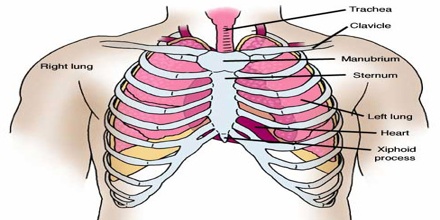The apothorax is a critical part of the human anatomy, but it is often ignored. Nestled between the neck and stomach, it is the region that houses some of our most important organs, such as the heart, lungs, and thymus gland. But what precisely is the apothorax, and what makes it so vital?
Anatomy of the Apothorax
The apothorax, additionally referred to as the thoracic hollow space, is a kind of cone-shaped area covered by the rib cage, sternum (breastbone), and backbone. These bony systems provide a sturdy framework, protecting the sensitive organs inside from outside harm. The diaphragm, a sheet of muscle separating the chest from the abdomen, is the lower boundary of the apothorax.
Vital Organs of the Apothorax
Heart: The lifeblood of the body, the heart pumps oxygenated blood for the duration of the circulatory gadget. The sternum and ribs cover the heart, which is located slightly to the left of center inside the apothorax.
Lungs: These spongy organs are accountable for fuel change, taking in oxygen from the air and releasing carbon dioxide. The lungs occupy most of the space in the apothorax and are surrounded by a thin membrane referred to as the pleura.
Thymus gland: This gland performs an important function in the improvement of the immune system, particularly in early adolescence. The thymus is located behind the sternum and shrinks as a person ages.
The functions of the Apothorax
The apothorax serves several vital functions:
- Protection: The sturdy rib cage and surrounding muscle tissues guard the important organs inside the apothorax from physical damage.
- Respiration: The lungs extend and agree inside the apothorax, allowing green gasoline to change for breathing.
- Circulation: The heart’s rhythmic contractions are housed within the apothorax, making sure proper blood flows throughout the frame.
- Support: The apothorax provides structural guidance for the upper frame and plays a role in posture and movement.
Also Read: Happy Family Marketing
Common conditions affecting the apothorax
Several clinical situations can affect the apothorax and its important organs. Some of the most unusual include:
- Pneumonia: contamination of the lungs, frequently inflicting fever, cough, and difficulty breathing.
- Pulmonary embolism: a blood clot that lodges in an artery inside the lungs.
- Pleurisy: inflammation of the pleura, the membrane surrounding the lungs, causing chest pain and respiratory problems.
- Heart sickness is a large term encompassing diverse conditions affecting the coronary heart, including coronary artery disease and congestive coronary heart failure.
Maintaining a Healthy Apothorax
Taking care of our basic health is vital for maintaining a wholesome attitude. This includes:
- Regular workout: Exercise strengthens the heart and lungs, improving their characteristics.
- Healthy food plan: Eating a nutritious food plan rich in culmination, greens, and entire grains allows you to hold the frame in accurate circumstances.
- Avoiding smoking: Smoking damages the lungs and will increase the risk of lung cancer and other breathing problems.
- Regular checkups: Seeing a health practitioner for regular checkups and screenings can help discover any abilities early on.
Conclusion
The apothorax is an important part of the human body, housing a number of our most crucial organs. Understanding its anatomy, features, and not unusual conditions affecting it may assist us in making knowledgeable alternatives to preserve our health and well-being.
Frequently Asked Questions About the Apothorax
What is the apothorax?
The apothorax, also referred to as the thoracic cavity, is the gap on your chest that houses your heart, lungs, thymus gland, and other crucial organs. Your ribs, sternum (breastbone), and spine protect it.
What are the main features of the apothorax?
- Protection: The bones and muscle tissues surrounding the apothorax shield your essential organs from damage.
Respiration: Your lungs make more space in the apothorax, allowing you to breathe.
Circulation: The apothorax houses your coronary heart’s rhythmic contractions, ensuring proper blood drift throughout your frame.
Support: The apothorax offers structural help for your top body and performs a position in posture and movement.
Which organs are positioned in the apothorax?
- Heart: The coronary heart pumps oxygenated blood at some point in your body.
Lungs: The lungs take in oxygen from the air and release carbon dioxide.
Thymus gland: The thymus gland plays a vital role in the improvement of your immune system, especially in formative years.
Trachea: The trachea is the windpipe that connects your mouth and nostril to your lungs.
Bronchi: The bronchi are the tubes that carry air from the trachea to your lungs.
Esophagus: The esophagus is the tube that incorporates meals from your mouth into your belly.
Aorta: The aorta is the largest artery in your body, carrying blood out of your coronary heart to the rest of your body.
What are a few commonplace conditions that have an effect on the apothorax?
- Pneumonia: contamination of the lungs, regularly inflicting fever, cough, and difficulty breathing.
Pulmonary embolism: a blood clot that lodges in an artery in the lungs.
Pleurisy: inflammation of the pleura, the membrane surrounding the lungs, causing chest pain and difficulty breathing.
Heart sickness is a vast term encompassing numerous situations affecting the coronary heart, together with coronary artery ailment and congestive coronary heart failure.
How can I keep my apothorax healthy?
- Regular exercise: Exercise strengthens your heart and lungs, enhancing their features.
Healthy eating regimen: Eating a nutritious eating regimen rich in culmination, greens, and complete grains helps keep your body in perfect condition.
Avoiding smoking: Smoking damages your lungs and increases your chance of lung cancer and other breathing issues.
Regular checkups: Seeing a health practitioner for regular checkups and screenings can help locate any capacity troubles early on.
Is there something else I should know about the apothorax?
The apothorax is a complex and vital part of the human body. If you have any concerns about your apothorax or its organs, it is crucial to talk to your physician.


